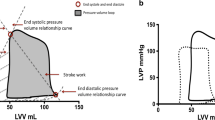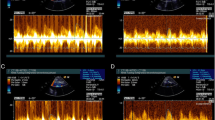Abstract
Coronary and systemic hemodynamic effects of verapamil have been investigated previously in detail. The acute impact of intracoronary verapamil on coronary hemodynamics has, however, not been correlated to simultaneously changes in myocardial metabolism or norepinephrine levels in humans. After bolus application of 1 mg verapamil into the left coronary artery of 52 patients scheduled for routine coronary angiography, heart rate (HR) remained unchanged, whereas mean arterial blood pressure (MAP) decreased (93.8 ± 14.9 mmHg to 85.1 ± 13.7 mmHg, p = 0.001). Coronary blood flow (CBF), calculated from intra-coronary Doppler measurements and quantitative coronary angiography, increased after verapamil administration (28.5 ± 16.7 ml/min to 66.2 ± 41.8 ml/min, p < 0.001), whereas coronary vascular resistance index (CVRI) decreased (1.43 ± 0.92 to 0.46 ± 0.23, p <0.001). Blood samples, taken simultaneously from the aorta (Ao) and coronary sinus (CS) at baseline and at maximal flow velocity, showed an increase in norepinephrine concentrations in Ao (209 ± 151 ng/I to 283 ± 195 ng/l, p <0.001) and CS (233 ± 162 ng/l to 323 ± 248 ng/l, p = 0.004). Myocardial metabolism of pyruvate and free fatty acids were not affected. Glucose release was augmented and initial lactate consumption changed to a net lactate release into the CS (Ao to CS differences: glucose: −1.92 ± 9.9 mg/dl to −12.8 ± 22.8 mg/dl, p < 0.001; lactate: 0.07 ± 0.2 mmol/l to −0.08 ± 0.3 mmol/l, p = 0.001). Similar results were obtained for the extraction ratios and flux of these metabolites. There was a weak correlation between the increase in CBF and lactate release into the CS. This is the first report of unexpected myocardial lactate release following intracoronary verapamil administration in humans. This lactate release was paralleled by an increased glucose release into the CS at an unchanged metabolism of free fatty acids and pyruvate. One explanation for this unexplained lactate release during increased coronary blood flow might be a wash out phenomenon of lactate from previous ischemic areas, other explanations might be the induction of paradox myocardial ischemia and/or a steal effect. Further studies are necessary to explain these unexpected findings of increased coronary flow and myocardial lactate release. Until reliable explanations are pending, studies using only lactate release as a marker of myocardial ischemia, without taken coronary and systemic hemodynamic parameters into account, should be interpreted with caution.
Similar content being viewed by others
References
Antman E, Muller J, Goldberg S, et al. Nifedipine therapy for coronary-artery spasm: Experience in 127 patients. N Engl J Med 1980; 302: 1269-1273.
Stone PH. Calcium antagonists for Prinzmetal's variant angina, unstable angina and silent myocardial ischemia: Therapeutic tool and probe for identification of pathophysiologic mechanisms. American Journal of Cardiology 1987; 59: 101B-115B.
Chouairi S, Carrie D, Puel J. Myocardial protection with calcium-channel blockers during ischaemia and reperfusion by PTCA. Eur Heart J 1995; 16(Suppl H): 3-8.
Vahanian A, Lung B. Role of calcium channel blockers in reducing acute ischemia and preventing restenosis in PTCA. Drugs 1996; 52: 9-15.
Oldenburg O, Baumgart D, Schaar J, et al. Anti-ischemic effect of verapamil within the scope of interventional revascularisation. Herz 1999; 24: 581-586.
Kaplan BM, Benzuly KH, Kinn JW, et al. Treatment of noreflow in degenerated saphenous vein graft interventions: Comparison of intracoronary verapamil and nitroglycerin. Catheterization Cardiovasc Diag 1996; 39: 113-118.
Piana RN, Paik GY, Monscucci M, et al. Incidence and treatment of ‘no-reflow’ after percutaneous coronary intervention. Circulation 1994; 89: 2514-2518.
Taniyama Y, Ito H, Iwakura K, et al. Beneficial effect of intracoronary verapamil on microvascular myocardial salvage in patients with acute myocardial infarction. J Am Coll Cardiol 1997; 30: 1193-1199.
Furberg CD, Psaty BM, Meyer JV. Nifedipine. Dose-related increase in mortality in patients with coronary heart disease. Circulation 1995; 92: 1326-1331.
Bagger JP, Nielsen TT. Influence of nifedipine on coronary hemodynamics and myocardial metabolism in coronary artery disease. Eur Heart J 1985; 6: 75-84.
Behrends M, Schulz R, Heusch G. Effects of verapamil and mibefradil on regional blood flow and function in normal and ischemic myocardium. Cardiovascular Drugs and Therapy 1999; 13: 275-276.
Dollery CT. Clinical pharmacology of calcium antagonists. Am J Hypertens 1991; 4: 88S-95S.
Grossman E, Messerli FH. Effect of calcium antagonists on plasma norepinephrine levels, heart rate, and blood pressure. American Journal of Cardiology 1997; 80: 1453-1458.
Shimada M, Nakamura Y, Iwanaga S, et al. Nonischemic ST-segment elevation induced by negative inotropic agents. Jpn Circ J 1999; 63: 610-616.
Baumgart D, Haude M, Ge J, et al. Online integration of intravascular ultrasound images into angiographic images. Catheterization Cardiovasc Diag 1996; 39: 228-229.
Baumgart D, Haude M, Liu F, Ge J, Görge G, Erbel R. Current concepts of coronary flow reserve for clinical decision making during cardiac catheterization. American Heart Journal 1998; 136: 136-149.
Grynberg A, Demaison L. Fatty acid oxidation in the Heart. J Cardiovasc Pharmacol 1996; 28(Suppl 1): S11-S17.
Sidi A, Davis RF. Lactate extraction fails to accurately re-flect regional lactate production in ischemic myocardium. J Cardiothorac Anesth 1989; 3: 321-328.
Di Mario C, Meneveau N, Gil R, et al. Maximal blood flow velocity in severe coronary stenoses measured with a doppler guidewire. American Journal of Cardiology 1993; 71: 54D-61D.
Zeiher AM, Drexler H, Wollschläger H, Just, H. Modulation of coronary vasomotor tone in humans. Progressive endothelial dysfunction with different early stages of coronary atherosclerosis. Circulation 1991; 83: 391-401.
Abernethy DR, Schwartz JB. Calcium-antagonist drugs. N Engl J Med 1999; 341: 1447-1457.
Staessen JA, Thijs L, Fagard RH, et al. Calcium channel blockade and cardiovascular prognosis in the Euoropean trial on isolated systolic hypertension. Hypertension 1998; 32: 410-416.
National Intervention Cooperative Study in Elderly Hypertensive Study Group. Randomized double-blind comparison of a calcium antagonist and a diuretic in elderly hypertensives. Hypertension 1999; 34: 1129-1133.
Schmieder RE, Messerli FH, Garavaglia GE, Nunez BD. Cardiovascular effects of verapamil in patients with essential hypertension. Circulation 1987; 75: 1030-1036.
Kailasam MT, Parmer RJ, Cervenka JH, et al. Divergent effects of dihydropyridine and phenylalkylamine calcium channel antagonist classes on autonomic function in human hypertension. Hypertension 1995; 26: 143-149.
Gloor HO, Urthaler F. Differential effect of verapamil isomers on sinus node and AV junctional region. Am J Physiol 1983; 244: H80-H88.
Forman R, Kirk ES. Comparative effects of vasodilator drugs on large and small coronary resistance vessels in dog. Cardivasc Res 1980; 14: 601-606.
Parodi O, Neglia D, Palombo C, et al. Comparative effects of enalapril and verapamil on myocardial blood flow in systemic hypertension. Circulation 1997; 96: 864-873.
Bagger JP. Myocardial metabolism in cardiac syndrome X. In: Kaski JC, Ed. Chest Pain with Normal Coronary Angiograms. Pathogenesis, Diagnosis and Management. Dordrecht, The Netherlands: Kluwer Academic Publishers, 1999.
Meyer U, Schiffer W, Schulz FW, Raff WK. Proceedings: Coronary steal phenomenon in intracoronary infusion of adenosine, nitroglycerine, persantin, intensain and nifedipine. Z Kardiol 1974; 10(Suppl 1): 33-35.
Schmier J, van Ackern K, Bruckner UB, Hakimi B, Heger W, Simo J. Investigations on the development of collaterals, coronary flow, tachyphylaxis and steal phenomenon in dogs after application of Adalat. New therapy of ischemic heart disease 1976; 1: 92-100.
Gustafsson D. Microvascular mechanisms involved in calcium antagonist edema formation. J Cardiovasc Pharmacol 1987; 10(Suppl 1): S121-S131.
Taherzadeh M, Warren JB. Comparison of diltiazem and verapamil on rat microvascular permeability. Microvasc Res 1997; 54: 206-213.
Iversen PO. Evidence for long-term fluctuations in regional blood flow within the rabbit left ventricle. Acta Physiol Scand 1992; 146: 329-339.
Klassen GA. Coronary artery disease. A cause of heterogenous myocardial perfusion. Cardiology 1971; 56: 343-347.
Ishihara M, Sato H, Tateishi H, et al. Effects of various doses of intracoronary verapamil on coronary resistance vessels in Myocardial Lactate Release 61humans. Jpn Circ J 1997; 61: 755-761.
Christensen CW, Rosen LB, Gal RA, Haseeb M, Lassar TA, Port SC. Coronary vasodilator reserve. Comparison of the effects of papaverine and adenosine on coronary flow, ventricular function, and myocardial metabolism. Circulation 1991; 83: 294-303.
Takeuchi M, Nohtomi Y, Kuroiwa A. Intracoronary papaverine induced myocardial lactate production in patients with angiographically normal coronary arteries. Catheterization Cardiovasc Diag 1996; 39: 126-130.
Author information
Authors and Affiliations
Rights and permissions
About this article
Cite this article
Oldenburg, O., Eggebrecht, H., Gutersohn, A. et al. Myocardial Lactate Release After Intracoronary Verapamil Application in Humans: Acute Effects of Intracoronary Verapamil on Systemic and Coronary Hemodynamics, Myocardial Metabolism, and Norepinephrine Levels. Cardiovasc Drugs Ther 15, 55–61 (2001). https://doi.org/10.1023/A:1011162818809
Issue Date:
DOI: https://doi.org/10.1023/A:1011162818809




